New Products & Services
October 2023
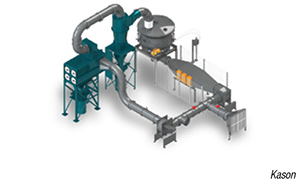 The new Vibro-Bed Energy Recovery System (ERS; photo) is an exhaust-air recycling system engineered to help material processors lower energy costs, reduce unpleasant odors and curb emissions. The Vibro-Bed ERS can be retrofitted onto this company’s and competitors’ fluidized-bed drying systems or added onto new equipment installations. A partial-loop drying system, ERS recycles a portion of the heated air exhausted by the fluidized bed, while removing excess water vapor from the airstream. A programmable logic controller (PLC) opens and closes a series of backdraft dampers, forcing the previously heated air back into the fluidized-bed dryer. Ideal applications for the ERS include those with exhaust-air temperatures that exceed 150°F (66°C); or large particle sizes that do not release moisture easily; or low drying rates for materials that have bound moisture content, such as grains, fruits and vegetables. — Kason Corp., Millburn, N.J.
The new Vibro-Bed Energy Recovery System (ERS; photo) is an exhaust-air recycling system engineered to help material processors lower energy costs, reduce unpleasant odors and curb emissions. The Vibro-Bed ERS can be retrofitted onto this company’s and competitors’ fluidized-bed drying systems or added onto new equipment installations. A partial-loop drying system, ERS recycles a portion of the heated air exhausted by the fluidized bed, while removing excess water vapor from the airstream. A programmable logic controller (PLC) opens and closes a series of backdraft dampers, forcing the previously heated air back into the fluidized-bed dryer. Ideal applications for the ERS include those with exhaust-air temperatures that exceed 150°F (66°C); or large particle sizes that do not release moisture easily; or low drying rates for materials that have bound moisture content, such as grains, fruits and vegetables. — Kason Corp., Millburn, N.J.
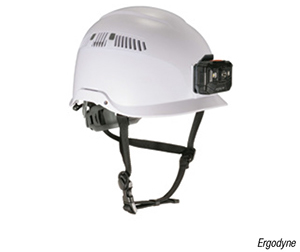 Four new safety helmets have been released as part of the Skullerz product line, including models with adjustable venting and rechargeable three-mode LED headlamps (photo). The newly developed Type 2 safety helmets provide comprehensive protection, offering safeguards to the top, front, side and rear of the head to meet the stringent ANSI/ISEA Z89.1-2014 (R2019) Type 2 requirements –– all without compromising on breathable comfort, a major point of concern among other Type 2 headgear, says the manufacturer. — Ergodyne, St. Paul, Minn.
Four new safety helmets have been released as part of the Skullerz product line, including models with adjustable venting and rechargeable three-mode LED headlamps (photo). The newly developed Type 2 safety helmets provide comprehensive protection, offering safeguards to the top, front, side and rear of the head to meet the stringent ANSI/ISEA Z89.1-2014 (R2019) Type 2 requirements –– all without compromising on breathable comfort, a major point of concern among other Type 2 headgear, says the manufacturer. — Ergodyne, St. Paul, Minn.
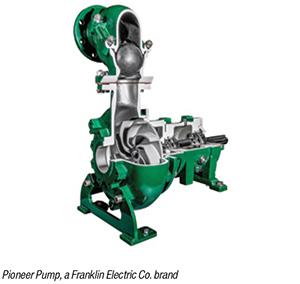 The Vortex Series of pumps (photo) are designed for handling abrasive wastes. Using a recessed impeller design, the series combines the efficiency characteristics of a self-priming pump with the solids-handling capabilities of a chopper pump. This makes it suitable for applications that need to pass solids while also handling flows to meet the application’s high total dynamic head (TDH) and gallons per minute (GPM) requirements. Recessed impellers assure that only about 15% of the solids that pass through the pump come into contact with the impeller, according to the manufacturer. Combining this impeller design with a vacuum-assisted priming chamber allows the pump to move both solids and fluids efficiently. The priming system also ensures rapid and unattended re-priming, and the run-dry lubrication system avoids premature failure of the seal and rotating assemblies. — Pioneer Pump, a Franklin Electric Co. brand
The Vortex Series of pumps (photo) are designed for handling abrasive wastes. Using a recessed impeller design, the series combines the efficiency characteristics of a self-priming pump with the solids-handling capabilities of a chopper pump. This makes it suitable for applications that need to pass solids while also handling flows to meet the application’s high total dynamic head (TDH) and gallons per minute (GPM) requirements. Recessed impellers assure that only about 15% of the solids that pass through the pump come into contact with the impeller, according to the manufacturer. Combining this impeller design with a vacuum-assisted priming chamber allows the pump to move both solids and fluids efficiently. The priming system also ensures rapid and unattended re-priming, and the run-dry lubrication system avoids premature failure of the seal and rotating assemblies. — Pioneer Pump, a Franklin Electric Co. brand
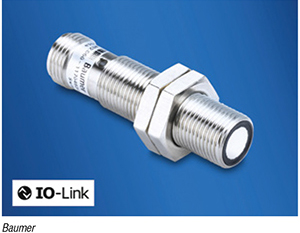 The new UR12 ultrasonic sensor (photo), in M12 size, is said to be the world’s shortest ultrasonic sensor, featuring a housing reduced down to a length of just 50 mm, along with a 15-mm “blind” area. These sensors provide a response time of up to 16 ms with a maximum detection range of 500 mm (1,000 mm for through-beam sensors). This allows design engineers more freedom in space-saving machine designs. As standard, the sensor features IO-Link interface for easy integration and delivery of valuable secondary data, while advanced functions ensure optimum sensor settings, such as easy configuration of sonic cones using this company’s Sensor Suite platform. For less demanding distance measurement applications, a retrofit product variant of is available without IO-Link. — Baumer Ltd., Swindon, U.K.
The new UR12 ultrasonic sensor (photo), in M12 size, is said to be the world’s shortest ultrasonic sensor, featuring a housing reduced down to a length of just 50 mm, along with a 15-mm “blind” area. These sensors provide a response time of up to 16 ms with a maximum detection range of 500 mm (1,000 mm for through-beam sensors). This allows design engineers more freedom in space-saving machine designs. As standard, the sensor features IO-Link interface for easy integration and delivery of valuable secondary data, while advanced functions ensure optimum sensor settings, such as easy configuration of sonic cones using this company’s Sensor Suite platform. For less demanding distance measurement applications, a retrofit product variant of is available without IO-Link. — Baumer Ltd., Swindon, U.K.
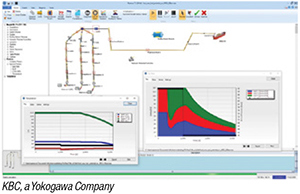 Maximus 7.4 software (photo) is a multiphase flow tool that simulates thermohydraulic conditions to help improve design and operational capabilities for sustainable energy projects, including carbon-capture and storage (CCS) applications. Maximus 7.4 flow-assurance software is equipped with integrated production-modeling capabilities that help production engineers optimize design and operational strategies to improve decision-making, asset performance and profits while reducing risks. Maximus 7.4 software assesses production risks, such as solid formations (hydrates, waxes, asphaltenes and scales), as well as facility erosion or corrosion. Improved compositional modeling seamlessly integrates Multiflash technology into Maximus software, enabling precise simulation of complex fluid flows for hydrogen, geothermal energy, liquefied natural gas (LNG) and CCS, as well as oil-and-gas production and transport. — KBC, a Yokogawa Company, Houston
Maximus 7.4 software (photo) is a multiphase flow tool that simulates thermohydraulic conditions to help improve design and operational capabilities for sustainable energy projects, including carbon-capture and storage (CCS) applications. Maximus 7.4 flow-assurance software is equipped with integrated production-modeling capabilities that help production engineers optimize design and operational strategies to improve decision-making, asset performance and profits while reducing risks. Maximus 7.4 software assesses production risks, such as solid formations (hydrates, waxes, asphaltenes and scales), as well as facility erosion or corrosion. Improved compositional modeling seamlessly integrates Multiflash technology into Maximus software, enabling precise simulation of complex fluid flows for hydrogen, geothermal energy, liquefied natural gas (LNG) and CCS, as well as oil-and-gas production and transport. — KBC, a Yokogawa Company, Houston
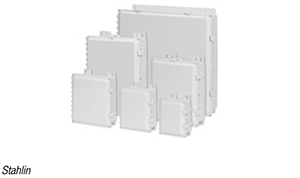 PolySlim low-profile enclosures (photo) accommodate existing panel designs, eliminate unneeded depth and material, optimize installations and save space. The low-profile design of PolySlim enclosures makes them suitable for use on building exteriors and in tight spaces. They protect equipment in non-hazardous industrial applications where space is a premium, and safeguard network components, such as routers and switches, in harsh conditions. PolySlim enclosures are well-suited for electrical control, wireless communications, measurement, monitoring and security applications with minimal-depth equipment. PolySlim polycarbonate enclosures are available in seven sizes and can be configured with a hinged-screw cover or a hinged-latched cover. PolySlim enclosures feature a nonmetallic hinge that does not penetrate the inside of the enclosure. Thick and smooth side-wall construction eliminates flexing and maximizes fitting mounting space. Additional benefits of PolySlim enclosures include inhibitors that protect against ultraviolet degradation. — Stahlin, Belding, Mich.
PolySlim low-profile enclosures (photo) accommodate existing panel designs, eliminate unneeded depth and material, optimize installations and save space. The low-profile design of PolySlim enclosures makes them suitable for use on building exteriors and in tight spaces. They protect equipment in non-hazardous industrial applications where space is a premium, and safeguard network components, such as routers and switches, in harsh conditions. PolySlim enclosures are well-suited for electrical control, wireless communications, measurement, monitoring and security applications with minimal-depth equipment. PolySlim polycarbonate enclosures are available in seven sizes and can be configured with a hinged-screw cover or a hinged-latched cover. PolySlim enclosures feature a nonmetallic hinge that does not penetrate the inside of the enclosure. Thick and smooth side-wall construction eliminates flexing and maximizes fitting mounting space. Additional benefits of PolySlim enclosures include inhibitors that protect against ultraviolet degradation. — Stahlin, Belding, Mich.
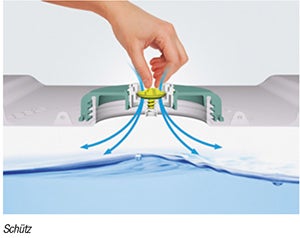 The new CC/FC ventilation system (photo) is integrated into the bung of the screw cap that covers the filling opening of intermediate bulk containers (IBCs), enabling users to proactively avoid contamination risks. It is used to quickly and safely ventilate the container during emptying via the bottom outlet fitting and prevents negative pressure that would cause the inner bottle to become deformed. In previous systems, either the screw cap, which is often sealed, had to be opened or the bung plug had to be removed completely with tools in an additional process step. With the CC/FC Breather, users simply twist a screw part manually to open the venting paths in the component. This also minimizes the risk of contamination during the entire emptying process. — Schütz GmbH & Co. KGaA, Selters, Germany
The new CC/FC ventilation system (photo) is integrated into the bung of the screw cap that covers the filling opening of intermediate bulk containers (IBCs), enabling users to proactively avoid contamination risks. It is used to quickly and safely ventilate the container during emptying via the bottom outlet fitting and prevents negative pressure that would cause the inner bottle to become deformed. In previous systems, either the screw cap, which is often sealed, had to be opened or the bung plug had to be removed completely with tools in an additional process step. With the CC/FC Breather, users simply twist a screw part manually to open the venting paths in the component. This also minimizes the risk of contamination during the entire emptying process. — Schütz GmbH & Co. KGaA, Selters, Germany
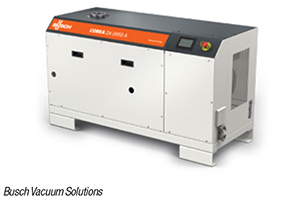 The Cobra DX 0950 A (photo) is the first vacuum pump to be released as part of the new DX Series. Cobra DX 0950 A is a dry vacuum pump with advanced screw-vacuum technology for excellent running characteristics, high vapor and particle tolerance and energy-efficient operation. The new pump is suited for many rough- and medium-vacuum applications, such as lithium battery production, drying, food packaging, coating and vacuum furnaces, or as the heart of a central vacuum system. An optimal vacuum level can be achieved at all times thanks to the intelligent driving unit with variable-speed control and various operating modes. This reduces energy consumption and ensures that the vacuum pumps run under optimal conditions. In addition, the patented self-balancing screw design of Cobra DX 0950 A ensures low vibration levels and quiet operation. The screws are made of one single casting and have no gaps. This prevents the ingress of process fluids or particles, as well as corrosion and deposits. — Busch Vacuum Solutions, Virginia Beach, Va.
The Cobra DX 0950 A (photo) is the first vacuum pump to be released as part of the new DX Series. Cobra DX 0950 A is a dry vacuum pump with advanced screw-vacuum technology for excellent running characteristics, high vapor and particle tolerance and energy-efficient operation. The new pump is suited for many rough- and medium-vacuum applications, such as lithium battery production, drying, food packaging, coating and vacuum furnaces, or as the heart of a central vacuum system. An optimal vacuum level can be achieved at all times thanks to the intelligent driving unit with variable-speed control and various operating modes. This reduces energy consumption and ensures that the vacuum pumps run under optimal conditions. In addition, the patented self-balancing screw design of Cobra DX 0950 A ensures low vibration levels and quiet operation. The screws are made of one single casting and have no gaps. This prevents the ingress of process fluids or particles, as well as corrosion and deposits. — Busch Vacuum Solutions, Virginia Beach, Va.
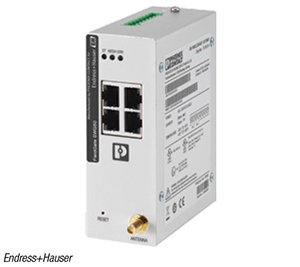 FieldGate SWG50 (photo) is a new WirelessHART gateway primed for secure communication from field devices, providing an easy-to-use solution for multiple-standard monitoring applications across various industries. FieldGate SWG50 is compact and designed for integration with Netilion, a cloud-based IIoT ecosystem designed for industrial processes, connecting the physical and digital worlds to send information from the field straight to a smartphone, tablet or another device. FieldGate SWG50 enables users to monitor measurements and health status using WirelessHART connectivity. This offering is an economical alternative to complex and costly cable installations, reducing expenditure for process automation by up to 30%, the company says. — Endress+Hauser, Inc., Greenwood, Ind.
FieldGate SWG50 (photo) is a new WirelessHART gateway primed for secure communication from field devices, providing an easy-to-use solution for multiple-standard monitoring applications across various industries. FieldGate SWG50 is compact and designed for integration with Netilion, a cloud-based IIoT ecosystem designed for industrial processes, connecting the physical and digital worlds to send information from the field straight to a smartphone, tablet or another device. FieldGate SWG50 enables users to monitor measurements and health status using WirelessHART connectivity. This offering is an economical alternative to complex and costly cable installations, reducing expenditure for process automation by up to 30%, the company says. — Endress+Hauser, Inc., Greenwood, Ind.
 The new i.Comp 8 and 9 oilless compressors (photo) are available in two sizes and three configurations (G, Tower and Tower T). The i.Comp units deliver oil-free air at up to 160 psi and 20 ft3/min. The direct-drive motor and oilless design eliminate nearly all routine service. Pressures can be precisely adjusted to each application’s requirements with the company’s Sigma Controller 2. i.Comp compressors are also available as Tower configurations, which include a receiver and drain trap, while Tower T configurations include a refrigerated dryer. A small footprint and low noise make i.Comp suitable for use in tight spaces. — Kaeser Compressors, Inc., Fredericksburg, Va.
The new i.Comp 8 and 9 oilless compressors (photo) are available in two sizes and three configurations (G, Tower and Tower T). The i.Comp units deliver oil-free air at up to 160 psi and 20 ft3/min. The direct-drive motor and oilless design eliminate nearly all routine service. Pressures can be precisely adjusted to each application’s requirements with the company’s Sigma Controller 2. i.Comp compressors are also available as Tower configurations, which include a receiver and drain trap, while Tower T configurations include a refrigerated dryer. A small footprint and low noise make i.Comp suitable for use in tight spaces. — Kaeser Compressors, Inc., Fredericksburg, Va.
![]() A new Block-Buster hydraulic bulk-bag conditioner (photo) features arched doorway masts that increase overhead clearance for easier insertion and removal of palletized bulk bags using a forklift. The conditioner loosens hygroscopic chemicals, spice blends, heat-sensitive products and other bulk materials that have solidified during storage and shipment, returning the material to a free-flowing state and enabling bulk-bag unloaders to discharge the material through bag spouts. A hydraulically-actuated, variable-height turntable operates in concert with two hydraulic rams to press opposing sides of the bulk bag at varying heights, rotate the bag 90 deg and then repeat the conditioning cycle. The number and pressure of hydraulic ram actuations, the height of the turntable and the number of 90-deg rotations are user-programmable at the control panel’s human-machine interface (HMI). — Flexicon Corp., Bethlehem, Pa.
A new Block-Buster hydraulic bulk-bag conditioner (photo) features arched doorway masts that increase overhead clearance for easier insertion and removal of palletized bulk bags using a forklift. The conditioner loosens hygroscopic chemicals, spice blends, heat-sensitive products and other bulk materials that have solidified during storage and shipment, returning the material to a free-flowing state and enabling bulk-bag unloaders to discharge the material through bag spouts. A hydraulically-actuated, variable-height turntable operates in concert with two hydraulic rams to press opposing sides of the bulk bag at varying heights, rotate the bag 90 deg and then repeat the conditioning cycle. The number and pressure of hydraulic ram actuations, the height of the turntable and the number of 90-deg rotations are user-programmable at the control panel’s human-machine interface (HMI). — Flexicon Corp., Bethlehem, Pa.
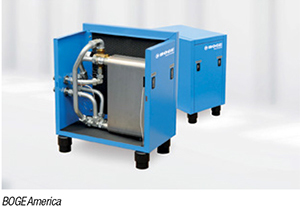 When this company’s heat-recovery components (photo) are installed onto an air compressor, up to 94% of the energy used to compress air is recovered. This recovered energy can be used to heat storage and operating areas or for heating water or oils. For example, the heat can be used for the treatment of drinking water, service water, heating water and process water. The latter is used for industrial washing processes, for example in recycling processes to clean plastic and synthetic materials. Heat-recovery components can be used to recover heat in both oil-injection-cooled and oil-free screw compressors. At the same time, the energy for cooling processes within the compressor is reduced, because the heat generated is conducted away and used elsewhere. The investment in heat-recovery components pays for itself within a few months depending on the application. — BOGE America, Inc., Powder Springs, Ga.
When this company’s heat-recovery components (photo) are installed onto an air compressor, up to 94% of the energy used to compress air is recovered. This recovered energy can be used to heat storage and operating areas or for heating water or oils. For example, the heat can be used for the treatment of drinking water, service water, heating water and process water. The latter is used for industrial washing processes, for example in recycling processes to clean plastic and synthetic materials. Heat-recovery components can be used to recover heat in both oil-injection-cooled and oil-free screw compressors. At the same time, the energy for cooling processes within the compressor is reduced, because the heat generated is conducted away and used elsewhere. The investment in heat-recovery components pays for itself within a few months depending on the application. — BOGE America, Inc., Powder Springs, Ga.
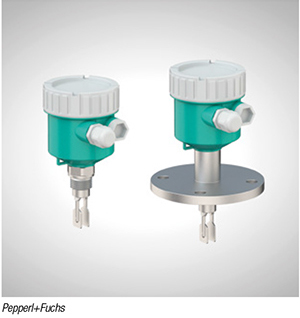 Vibration limit switches reliably detect the fill level of liquids at all times. With Vibracon LVL-M3 and -M4 (photo), this company offers two new series of vibration limit switches that can be used worldwide in hazardous areas due to ATEX and IECEx approvals. The LVL-M3 version is suitable for universal use in all pumpable liquids. The vibration limit switch can withstand process temperatures of –40 to 150°C and process pressures of up to 40 bars. The LVL-M4 version is suitable for safety applications up to SIL 3. The sensor is resistant to process temperatures of –50 to 150°C and process pressures up to 100 bars. The LVL-M4 version has a Bluetooth interface that can be used to connect the device to the company’s Level App. This mobile application enables status and fault indication to proof testing. — Pepperl+Fuchs SE, Mannheim, Germany
Vibration limit switches reliably detect the fill level of liquids at all times. With Vibracon LVL-M3 and -M4 (photo), this company offers two new series of vibration limit switches that can be used worldwide in hazardous areas due to ATEX and IECEx approvals. The LVL-M3 version is suitable for universal use in all pumpable liquids. The vibration limit switch can withstand process temperatures of –40 to 150°C and process pressures of up to 40 bars. The LVL-M4 version is suitable for safety applications up to SIL 3. The sensor is resistant to process temperatures of –50 to 150°C and process pressures up to 100 bars. The LVL-M4 version has a Bluetooth interface that can be used to connect the device to the company’s Level App. This mobile application enables status and fault indication to proof testing. — Pepperl+Fuchs SE, Mannheim, Germany
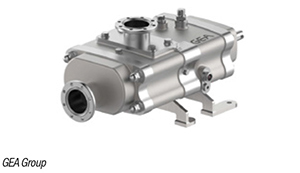 This company launched a new generation of twin-screw pumps for food, beverage and pharmaceutical applications that combine both the conveying and cleaning functions in one pump. The revamped Hilge Novatwin+ twin-screw pump (photo) is more powerful than its predecessor series, and thanks to its higher flowrate, covers a wider range of applications with a smaller pump. Users not only reduce their material footprint by 23% with the new design, but also reduce energy demand by 10% due to the improved efficiency. With variable speeds of up to 3,000 rpm, the self-priming positive-displacement pump conveys lumpy, shear-sensitive and abrasive media particularly gently. It can handle liquids with a wide range of viscosities. Since the Novatwin+ pumps operate with nearly no pulsation, they are also suitable for large and sensitive particles. Twin-screw pumps can also serve as clean-in-place (CIP) pumps, because they can be operated at very high speeds. The system pressure of 30 bars also allows for use in high-pressure applications. — GEA Group, Düsseldorf, Germany
This company launched a new generation of twin-screw pumps for food, beverage and pharmaceutical applications that combine both the conveying and cleaning functions in one pump. The revamped Hilge Novatwin+ twin-screw pump (photo) is more powerful than its predecessor series, and thanks to its higher flowrate, covers a wider range of applications with a smaller pump. Users not only reduce their material footprint by 23% with the new design, but also reduce energy demand by 10% due to the improved efficiency. With variable speeds of up to 3,000 rpm, the self-priming positive-displacement pump conveys lumpy, shear-sensitive and abrasive media particularly gently. It can handle liquids with a wide range of viscosities. Since the Novatwin+ pumps operate with nearly no pulsation, they are also suitable for large and sensitive particles. Twin-screw pumps can also serve as clean-in-place (CIP) pumps, because they can be operated at very high speeds. The system pressure of 30 bars also allows for use in high-pressure applications. — GEA Group, Düsseldorf, Germany
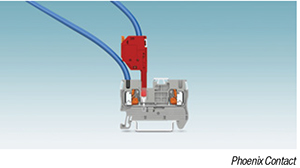 This lever technology (photo) enables fast and effort-saving multiple wiring of different conductor types with and without ferrules. The connectors are simply integrated into the function shaft of the terminal blocks. Various tests can be carried out quickly and easily with the LPS service connectors. The contact springs have a silver-plated surface to ensure permanent and consistent quality. The company’s LPO load-contact connectors enable the easy integration of additional load contacts. This means the LPO connectors provide a significant advantage, especially if design changes are necessary in the control cabinet. The special design enables a durable and robust connection. The new connectors feature maximum ease of use, a secure connection, high flexibility and fast installation. — Phoenix Contact GmbH & Co. KG, Blomberg, Germany
This lever technology (photo) enables fast and effort-saving multiple wiring of different conductor types with and without ferrules. The connectors are simply integrated into the function shaft of the terminal blocks. Various tests can be carried out quickly and easily with the LPS service connectors. The contact springs have a silver-plated surface to ensure permanent and consistent quality. The company’s LPO load-contact connectors enable the easy integration of additional load contacts. This means the LPO connectors provide a significant advantage, especially if design changes are necessary in the control cabinet. The special design enables a durable and robust connection. The new connectors feature maximum ease of use, a secure connection, high flexibility and fast installation. — Phoenix Contact GmbH & Co. KG, Blomberg, Germany
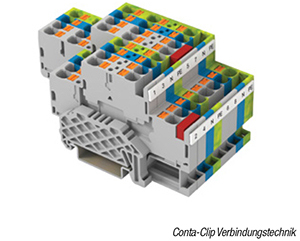 This company has introduced new space-saving two-level terminals for rated wire cross-sections up to 4 mm². The compact PRKD 4 terminal blocks and the corresponding PSLD 4 PE terminals (photo) are available with two or three ports per level and halve the required installation space. In addition to the small footprint, both series are characterized by a large variance and particularly easy handling due to enlarged insertion channels and minimized engaging force. An integrated pusher, which can be operated with light pressure without special tools, is used to quickly disconnect wires. The terminal design and vertical wire insertion from above enable installation close to the wiring channels and thus very compact setups in the field. The high contact force of the push-in spring ensures secure fixation of the wire ends that withstands even strong vibrations and mechanical shocks. — Conta-Clip Verbindungstechnik GmbH, Hövelhof, Germany
This company has introduced new space-saving two-level terminals for rated wire cross-sections up to 4 mm². The compact PRKD 4 terminal blocks and the corresponding PSLD 4 PE terminals (photo) are available with two or three ports per level and halve the required installation space. In addition to the small footprint, both series are characterized by a large variance and particularly easy handling due to enlarged insertion channels and minimized engaging force. An integrated pusher, which can be operated with light pressure without special tools, is used to quickly disconnect wires. The terminal design and vertical wire insertion from above enable installation close to the wiring channels and thus very compact setups in the field. The high contact force of the push-in spring ensures secure fixation of the wire ends that withstands even strong vibrations and mechanical shocks. — Conta-Clip Verbindungstechnik GmbH, Hövelhof, Germany
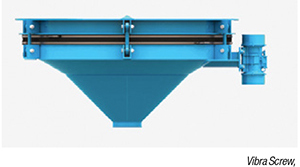 This company’s Bin Activators (photo) help to eliminate bridging and ratholing in bulk-solids handling applications. They also reduce particle segregation and promote improved mass flow. The company offers a number of Bin Activator designs to meet a wide range of processing requirements: the original Dished Head design; the Model HDBD, which uses a compound slope body; and the Rolled Cone Bin Discharger design. For trouble-free installation, a pre-assembled mounting ring is offered. A patented beaded sleeve helps to avoid issues related to leakage and slippage. Users can choose from oil- or grease-lubricated vibrators for their system. — Vibra Screw, Inc., Totowa, N.J.
This company’s Bin Activators (photo) help to eliminate bridging and ratholing in bulk-solids handling applications. They also reduce particle segregation and promote improved mass flow. The company offers a number of Bin Activator designs to meet a wide range of processing requirements: the original Dished Head design; the Model HDBD, which uses a compound slope body; and the Rolled Cone Bin Discharger design. For trouble-free installation, a pre-assembled mounting ring is offered. A patented beaded sleeve helps to avoid issues related to leakage and slippage. Users can choose from oil- or grease-lubricated vibrators for their system. — Vibra Screw, Inc., Totowa, N.J.